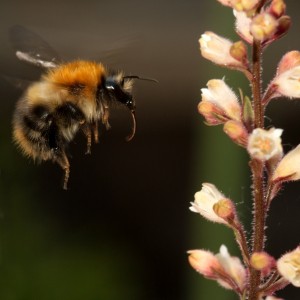10
Oct
Neonicotinoids Called “Bigger Threat” to Environment than DDT
(Beyond Pesticides, October 10, 2014) Many officials are no longer mincing words as they tie the global decline in bee populations with mounting evidence pointing to neonicotinoid pesticides. “All the science is not done, but everything that I have before me. . . suggests to me that this is the biggest threat to the structure and ecological integrity of the ecosystem that I have ever encountered in my life, bigger than DDT, ” said Environmental Commissioner Gord Miller, of Ontario, Canada, as he released his annual report. The Annual Report of the Environmental Commissioner of Ontario, which has been released since 1994, has in recent years found particular scrutiny falling on neonicotinoids.
 Dichloro-diphenyl-trichloroethane, more commonly known as DDT, was banned in Canada and in the United States in 1972, following a massive environmental movement spurred by Rachel Carson’s Silent Spring, which documented the adverse environmental effects resulting from the indiscriminate use of pesticides.
Dichloro-diphenyl-trichloroethane, more commonly known as DDT, was banned in Canada and in the United States in 1972, following a massive environmental movement spurred by Rachel Carson’s Silent Spring, which documented the adverse environmental effects resulting from the indiscriminate use of pesticides.
Mr. Miller called bees the “canary in the coal mine” on neonicotinoids, and said the impact of the pesticides is “clearly more wide scale” in the ecosystem.
Neonicotinoids are chemically similar to nicotine and are pesticides that are toxic to a broad range of insect pests. They are also known as systemic pesticides, which are pesticides that spread throughout the entire plant structure, making everything from roots to pollen toxic to organisms that come in contact with it. As a result of neonicotinoids systemic nature, pre-treatment practices, and other factors these dangerous pesticides have been linked to the global disappearance of honey bees and other non-target organisms, such as earthworms, birds, and aquatic invertebrates.
The report highlights the case of the endangered rusty-patched bumble bee (Bombus affinis) which was once the fourth most common bumble bee species in southern Ontario. The species is now virtually absent throughout most of its historic range. The report mentions that long-term population trends are declining for several wild bee species, as well as butterflies, bats, and hummingbirds.
The Ontario Beekeepers Association stated that Ontario lost 58 percent of its hives last year. The group complained that the government has not acted on previous warnings about neonicotinoids and should outlaw the pesticides immediately.
Recently, Ontario beekeepers decided to take matters into their own hands by filing a class action lawsuit against two makers of neonicotinoids. The lawsuit alleges that Syngenta and Bayer CropScience were negligent in the design, sale, manufacture, and distribution of neonicotinoid pesticides and this negligence caused the plaintiffs, Sun Parlor Honey and Munro Honey, to suffer $450 million in damages. These alleged damages are based on losses from damaged or lost bee colonies, decreased honey production, lost profits, and unrecoverable costs ””all because of neonicotinoids.
Here in the U.S., Beyond Pesticides, Center for Food Safety, Pesticide Action Network North America, and U.S. beekeepers filed a lawsuit against the U.S. Environmental Protection Agency (EPA) in 2013 calling for a ban on clothianidin and thiamethoxam, which are used extensively on corn, soybean and canola seeds.
Join Beyond Pesticides in supporting beekeepers across North America in their fight against neonicotinoids and learn the many ways you can BEE Protective by visiting our website! You can also learn more about the growing body of science linking bee deaths to neonicotinoids by visiting Beyond Pesticides’ What the Science Shows.
All unattributed positions and opinions in this piece are those of Beyond Pesticides.










